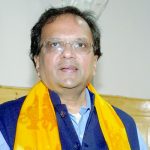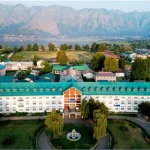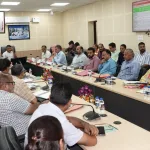The recently presented J&K budget is not just disappointing—it is a document of deception, lacking vision, transparency, and a clear roadmap for economic progress. Rather than offering fiscal prudence, it is a collection of misleading figures and exaggerated claims, designed to paint an illusion of growth while ignoring the ground realities of Jammu and Kashmir’s struggling economy. Austerity is not just a slogan—it is a way of governance.
Late Mufti Mohammad Sayeed, even as India’s Home Minister, lived in a modest 1,200 sq. Ft. Apartment. Compare this to today’s leaders who preach financial restraint but indulge in extravagance. This administration has failed to adopt cost-cutting measures or negotiate meaningful financial aid, unlike the pragmatic approach taken by Mufti Sayeed in 2014 for Jammu & Kashmir and Ladakh.
Exaggerated Economic Claims
The government claims that the tertiary sector contributes 61.70% to J&K’s economy, but this assertion does not hold up under scrutiny. Tourism, a crucial component of this sector, cannot thrive when infrastructure is crumbling, airline fares are prohibitively high, and visitors are forced to choose between overpriced luxury stays and substandard budget options. Middle-class tourists, the backbone of India’s tourism economy, are being driven away—yet the administration boasts of growth. This is nothing more than a mathematical illusion designed to mislead.
In the primary sector, the budget conveniently omits any mention of key industries like mining and minerals. Despite the discovery of lithium reserves in Samba, the government has failed to disclose any economic contribution from this valuable resource. If these reserves are being accounted for, where is the mention of royalty revenues? Or does the government itself not know where these resources are heading? This silence raises serious concerns about transparency and mismanagement. Similarly, the secondary sector’s projected 19% share in the economy is an inflated figure with no basis in reality. Where are the industries contributing to this number? With no large-scale manufacturing, minimal industrial output, and no major investments in production, this claim is a fabrication. The government owes the people an explanation—what methodology was used to arrive at these numbers?
A Budget That Lacks Accountability
The budget includes a massive Rs 12,000 crore capital expenditure allocation for rural development, irrigation, healthcare, and housing. While investment in these sectors is essential, history has shown that such funds often become easy targets for corruption and mismanagement. From the 1980s to the post-1996 era, financial irregularities have plagued J&K, and this administration is no exception. Without strict accountability, this money will enrich a few rather than uplift the region. Another major concern is J&K’s overdependence on central assistance. The region generates only 30% of its revenue receipts and 25% of its budgetary needs independently, making it one of the least self-sufficient economies in the country.
With Rs 17,000 crore coming from central assistance and additional borrowings keeping the economy afloat, where is the roadmap for financial autonomy? A region that survives on grants and loans cannot claim to be economically stable. The government’s unrealistic tourism projections are another glaring issue. The claim that J&K will witness 2.36 crore tourist arrivals in 2024 and that tourism will contribute 15% to GSDP within five years is nothing but an empty promise. Where is the infrastructure to support such numbers? Where is the policy for sustainable tourism? These projections exist only on paper, not in reality.
Agriculture, Power and Employment
Empty Promises Despite a Rs 5,013 crore allocation for the Holistic Agriculture Development Program, the budget fails to address critical issues like low irrigation coverage, lack of cold storage facilities, weak supply chains, and limited access to competitive markets for farmers. The two-crop pattern initiative is meaningless without specifics on its implementation across J&K’s diverse terrains.
Agriculture is not just about allocating money; it requires well-planned systems. In the power sector, the administration claims that under-recovery losses have been reduced from Rs 6,552 crore in 2022-23 to Rs 5,244 crore in 2023-24, but this is merely a numbers game. Aggregate Technical & Commercial (AT&C) losses remain at a staggering 41%, while public debt has soared to 52% of GSDP. The administration expects people to believe that billing reforms alone will fix this crisis, but without a concrete roadmap, J&K’s power sector will remain a financial black hole.
Employment promises made under Mission YUVA are equally vague. The claim of creating 4.25 lakh jobs over five years lacks specifics—where will these jobs come from? What training will be provided? How will these trained youth be absorbed into employment? The government itself admits to delays in JKPSC and JKSSB recruitments yet makes grand statements about job creation without a clear timeline. A government that cannot even manage its recruitment backlog has no business making hollow promises about employment.
Healthcare and Industrial Policy
Missing the Mark While Rs 1,750.50 crore has been allocated for healthcare, the budget ignores the doctor shortages in rural areas, fails to provide a plan for district hospitals, and lacks a strategy for strengthening primary health centers. Cancer treatment and maternal health services remain severely inadequate, with only two State Cancer Institutes planned—an utterly insufficient response to the rising healthcare needs of the population.
The government also boasts about having 64 existing industrial estates and 46 more under development, yet it has no clear strategy for attracting large-scale industries. Where are the implementation timelines for the Rs 28,000 crore industrial package? Where are the tax incentives for MSMEs? Where is the framework for IT and biotech expansion? Without a proper industrial policy, this so-called industrial push will remain mere rhetoric.
A Budget without Reforms Is Just a Speech
The biggest failure of this budget is its lack of a long-term strategy for fiscal sustainability. Committed expenditures like salaries and pensions consume nearly 60% of revenue expenditure. A region that spends more on running its government than on developing its economy is heading toward bankruptcy.
The administration has also failed to introduce new tax reforms, missing a crucial opportunity to boost J&K’s revenue base. It claims to have utilized 97% of the Rs 58,466 crore under the PM Development Package (PMDP-2015), yet it refuses to provide a transparent performance audit of these projects. Even social welfare schemes such as free ration, marriage assistance, and free transport for women remain plagued by inefficiencies. Without proper execution, these are hollow promises, not policies.
In the end, this budget is nothing more than a grand speech—long on words but short on execution, financial clarity, and accountability. A budget without reforms is just a piece of paper. A government without transparency is just a regime. And a promise without a plan is just a lie.
(The Author is Political Leader Jammu & Kashmir Peoples Democratic Party (PDP). Advocate for Regional Stability, Development & Societal Well-being. Feedback: [email protected])








